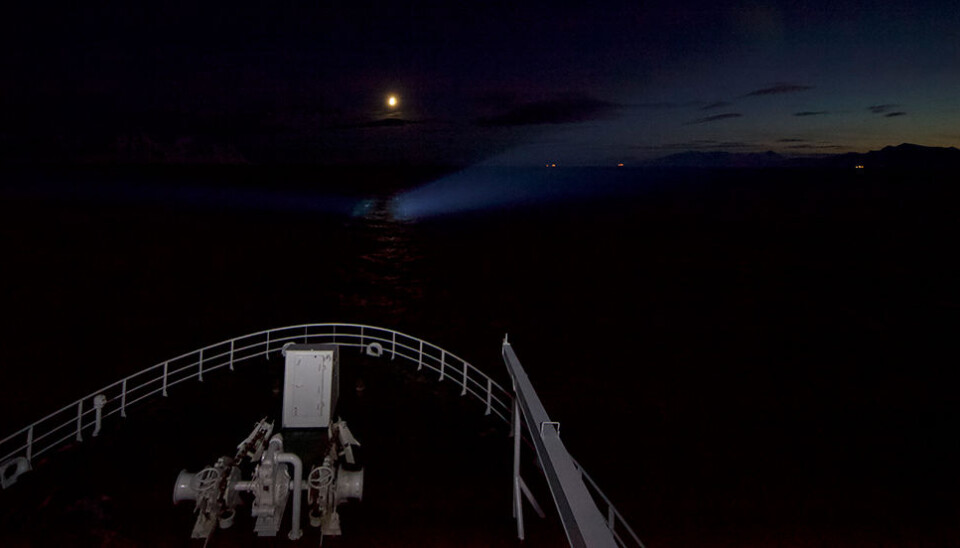This article is produced and financed by NTNU Norwegian University of Science and Technology - read more

Arctic light pollution affects fish and zooplankton up to 200 metres deep
If artificial light shines into the Arctic Ocean during the polar night, does it matter? A new paper in Communications Biology says the answer to this is a strong yes.

The Arctic polar night is a time when the sun remains below the horizon for a full 24-hour cycle. It is dark, but not completely. Nevertheless, the lack of light has long led researchers to assume that the organisms that live through this dark period are mostly dormant.
For a decade, an international team of researchers has been exploring the polar night to see exactly how organisms survive in the dark.
Over the course of their surveys, they’ve learned the only way they can really understand what’s going on is to turn out the lights on their research vessels and rely on autonomous underwater vehicles that need no light to do their work.
And when they’ve done that, they’ve found birds that dive into the nearly pitch-black ocean to feast on bioluminescent plankton and krill, and deepwater fishes that normally live at great depths foraging in kelp beds just 2 metres deep, to name just a few.
“As the sun becomes less and less visible on the sky, the relative importance of the moon, the stars and even the aurora borealis becomes more and more important,” says Jørgen Berge, a biologist at UiT – The Arctic University of Norway and NTNU who headed the international research team.
Now, Berge and his team, which also includes scientists from the UK, Canada and the US, has been able to quantify just how much light can affect the behaviour of all these creatures. Their results have been published in Communications Biology.
Light pollution

It turns out it doesn’t take much light to affect organisms at all, the researchers found. Some reacted to light levels as low as one millionth that of daylight, including algal cells that entered a photoactive state a full six weeks before the return of sunlight. So much so that all previous biological surveys of everything from plankton to fish stocks may be fundamentally wrong, the researchers say.
“We have been able to document light-regulated biological processes that are still ongoing throughout the polar night,” Berge said. “Many species of fish and zooplankton remain active and migrate vertically in the water column over a 24-hour period. These migrations are fully regulated by small changes in either sunlight or moonlight.”
Geir Johnsen, a biologist at NTNU who was one of the authors of the paper, says this sensitivity was surprisingly extreme — and has important consequences.
“Even the light from a research vessel, or a vessel estimating the stock size of zooplankton and fish, can influence organisms down to 200 metres below the ocean surface. They can either be attracted to the light or flee from it,” Johnsen said. “All of this makes it very difficult to say anything accurate about behaviour or populations, and stock assessments of fish may be influenced by this at nighttime all over the world.”

Johnsen is a key scientist at NTNU’s “Autonomous Marine Operations and Systems (AMOS) Centre of Excellence, where he describes his role as “trying to merge enabling technology with the natural sciences.
In this situation, he says, where light is so critically important, the researchers need to use autonomous robots that don’t need any artificial light and that can give them information that is not affected by artificial light, Johnsen says.
This ability to study the dark without disturbing it is how the team was able to determine how profoundly light could upset behaviours that were normally tuned to the polar darkness.
Less ice, more light
This picture is complicated by global warming, the researchers say. Arctic sea ice is melting faster than at any time in recorded history, and growing human activity in the Arctic, with respect to fisheries, oil and gas, mineral extraction, new transport routes and tourism, is rapidly increasing as areas become free of ice.
Consequently, light pollution is pouring into the Arctic, and is now thought to be among the fastest growing sources of pollution in the region.
Johnsen says it’s critical for researchers to learn as much as they can about how this ecosystem works before it is irreparably changed.
“About 50 percent of the oxygen that we breathe is from these microscopic algae in the world’s oceans. Without those key groups there would be no life. Simple as that,” he says.
A movie and a book
Over this past year, the research team has also worked on the movie project “Into the Dark”, which attempts to unravel the mystery of the polar night.
The movie mostly follows Berge, who is head of the Polar Night project and includes David McKee from the University of Strathclyde, Glasgow, and Johnsen. It premiered in Tromsø in mid-January and will be shown at a number of film festivals throughout the year.
“The film director, Michael Snyder, managed to get the best from us, and the team was brilliant. They followed us closely, and were very thorough in making sure that the science was presented correctly, stating the take home messages to a larger audience globally,” Johnsen said.
References:
Berge, Johnsen and their colleague Jonathan Cohen from the University of Delaware are also editors of a book that will be published in mid-March on their research. The book is entitled Polar Night: Marine Ecology, Life and Light in the Dead of Night.
Reference: Berge, J., Geoffroy, M., Daase, M. et al. Artificial light during the polar night disrupts Arctic fish and zooplankton behaviour down to 200 m depth. Commun Biol 3, 102 (2020). https://doi.org/10.1038/s42003-020-0807-6


































